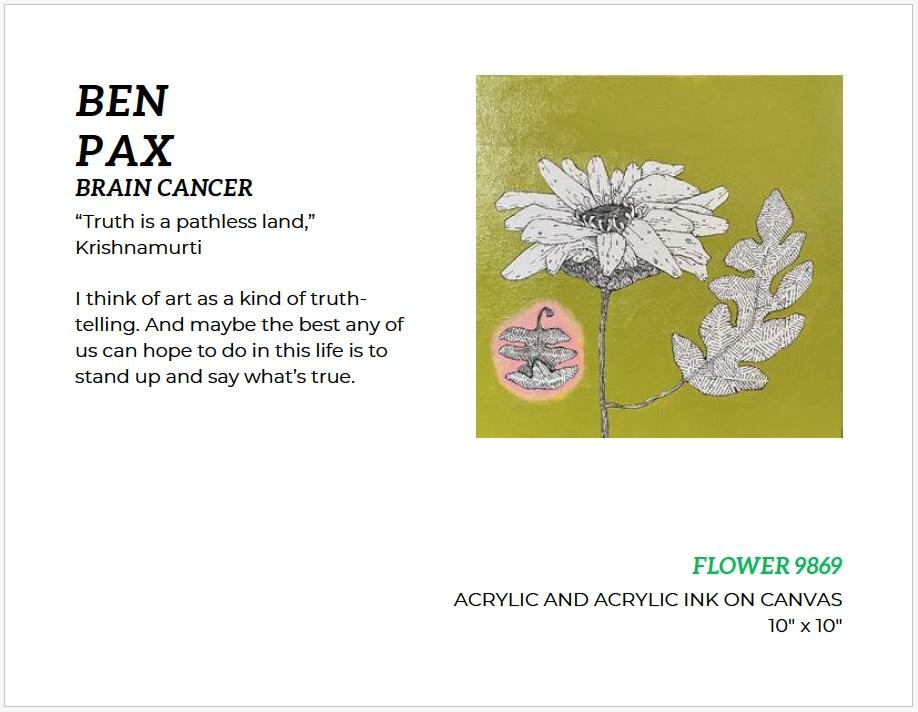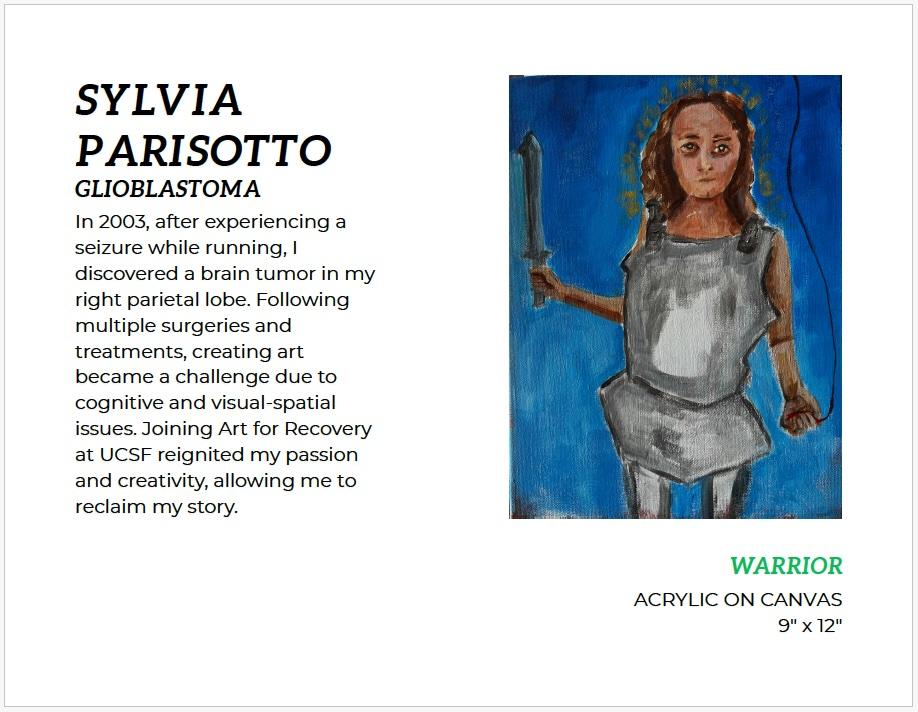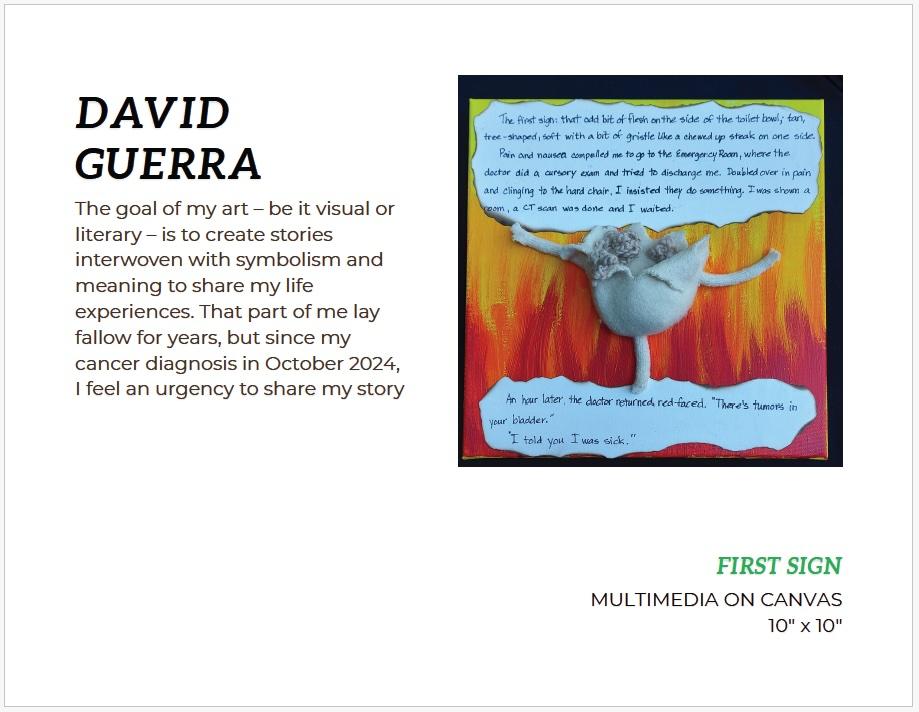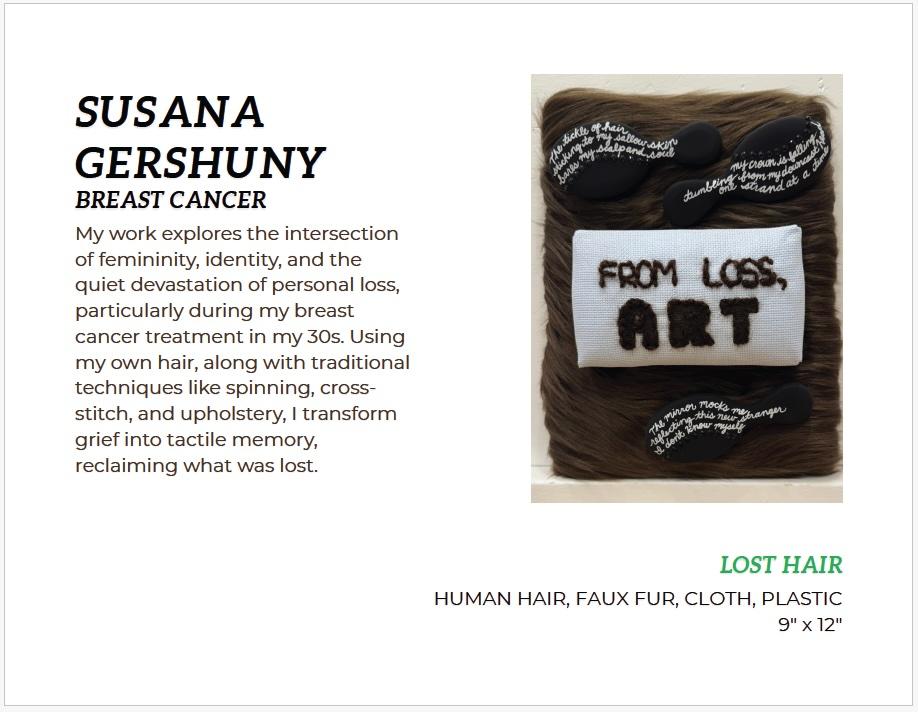
They aren’t professional artists, and to have their work featured by a major metropolitan museum seemed unfathomable.
They’d been diagnosed with a gamut of cancers including brain cancer, breast cancer, multiple myeloma, colon, ovarian cancer. Some were diagnosed many years ago, others as recently as last year.
Each sought refuge, self-expression through UCSF’s Art for Recovery.
And now the art of 30 patients is being showcased at the San Francisco Museum of Modern Art (SFMOMA), one of the largest modern and contemporary museums in the U.S. From paintings to collages to textiles, the art will be on view until spring 2026. It’s believed to be the first time a major museum has featured the artwork of patients at a medical center.
Art for Recovery | SF MOMA
Fall 2025–Spring 2026
Steps Coffee Community Art Show
“We work with such incredible people,” said Art for Recovery Director Amy Van Cleve, who was deeply instrumental in bringing about the special installation.
“Patients write poems about their experiences, they paint, they write short stories. It gives some people closure, it brings some people meaning. People can say to themselves ‘If your illness was a monster, what would it look like?’ The art gives people a voice during a scary, silent time.”
Art for Recovery was launched 37 years ago at the UCSF Helen Diller Family Comprehensive Cancer Center to offer creative, compassionate support for adults with cancer or HIV/AIDS. It provides free art, writing and music to more than 200 patients a week at their bedside or online, at UCSF Health hospitals, and at the UCSF Health Berkeley Outpatient Center. Currently, the youngest patient is 19, the oldest is in his 80s.
Studies have long shown that art can be highly therapeutic, helping patients to address trauma, to find positive meaning in their illnesses. The focus is not on artistic skill but on the therapeutic process.
Here are a few of the patients’ stories.
Ben Pax – Brain Cancer

Ben Pax was diagnosed in 1999 with tonsil cancer, then a tumor in his brain 10 years later. He had surgery, then more surgery and radiation in 2015 when the tumor returned, lodging at the base of his skull.
“No one would touch it, only UCSF,” he says. “It was very successful. The tumor would have killed me.”
Pax says that Art for Recovery provides an important creative outlet for patients at a time when words may not suffice, “to talk about things that are very hard to talk about.”
Pax’s art often features flowers, and his SFMOMA painting of acrylic paint and acrylic ink is titled “Flower 9869.”
“I think of art as a kind of truth-telling,” he says. “And maybe the best any of us can hope to do in this life is to stand up and say what’s true.”
Sylvia Parisotto – Glioblastoma

For more than two decades, Sylvia Parisotto has lived with glioblastoma, an aggressive cancer that often proves deadly. Diagnosed at 32, the Richmond resident is now 55 and grateful that her brain tumor was operable, though she’s endured six surgeries and numerous chemotherapy regimens.
As a preschooler, she remembers drawing on her living room walls in orange crayon. In college, she studied art and art history and has skirted around the art world much of her life, even working as a grant writer at the Berkeley Art Museum.
“Art was always important to me, but I didn’t think I was good enough,” she says.
Then she reignited her passion through Art for Recovery.
Her SFMOMA artwork is an acrylic depiction, on 9”x12” canvas, of a warrior, embodying her strength, her ability to fight against despair.
“Art for Recovery saved my life,” she says. “It is so inspiring, so supportive, so cathartic, so empowering. It helped me find my artistic voice. When you are going through cancer, you are very vulnerable. This is a battle, the treatments are challenging -- the cancer is me, it’s my cells that have gone rogue.
“When I was first diagnosed, I thought cancer is not going to take my joy. I wanted to live a life of meaning and purpose. Hopefully, I can show that through my art.”
David Guerra – Bladder Cancer

Early this year, David Guerra’s tumor-ridden bladder was removed, replaced by a “very pretty” alternative. Now 65 and living in Oakland, Guerra retired from working variously as a nurse, seamstress, administrative assistant for the Oakland School for the Arts.
Guerra was a fulltime caregiver until the death of their husband, Claude, two years ago. “I was so busy taking care of him, I let some of my own health slide. But then I saw blood in my urine and had stomach pain.”
Their art is a multimedia interpretation of a bladder with flames in the background and the edges burned, using acrylic paint, paper, fabric, yarn.
“It is mindblowing to be at SFMOMA, it’s something I never imagined could happen,” Guerra says. “The idea that something I created is going to be at the museum is unbelievably awesome. I’m going to be dragging friends there for months, ‘Come on, let’s go see my art.’ Cancer tried to destroy me, but hopefully I will be ok for a long, long time.”
Susana Meyer Gershuny – Breast Cancer

The last year has been a whirlwind for Susana Meyer Gershuny. In November 2024, she was diagnosed with breast cancer. She was 35 and both her children were still in cribs.
A month later, she had a double mastectomy. A month after that she started on chemotherapy. Then she had surgery removing her ovaries and uterus.
Since age 25, Gershuny knew she had the BRCA 1 mutation and had been regularly screened at UCSF, in fact she was planning a prophylactic mastectomy for January 2025.
“They found the tumor, and I went quickly into being treated for cancer instead – the best laid plans…” she says ruefully.
Gershuny, who lives with her husband and children in Piedmont, wrote a storybook, “Mommy’s Boo-Boo,” to help her children understand that she couldn’t lift them after surgery, but they could do other things, like cuddle and play games together.
“Your kids still need to eat their meals,” she says. “You don’t have time to slow down and think about what is happening to you.”
Being in Art for Recovery gave her a welcome brake. Gershuny had no formal art training and had never done art therapy, but she’s loved art since childhood. Sharing her story with other patients -- some in remission, some with terminal disease -- left her feeling centered.
“So much of the experience of being treated for cancer lives in your head,” she says. “But the practice of making art takes the focus from your head to your hands. When I take my fear and anxiety and I create something with it, it makes the thing I’ve been grappling with feel less scary. At Art for Recovery, we are a community. We’re from different walks of life, but these are people I have bared my soul to.”
Gershuny is now out of active treatment. Her primary medium is sculpture and for the SFMOMA show, her woven artwork – titled “Lost Hair” -- used her own strands of hair, gathered during chemotherapy.
“I can’t tell you how over the moon I am to be hanging in a major metropolitan museum,” she says. “To say it is an honor is an understatement. I now, more than ever, wholeheartedly believe everyone should do art therapy, even if you don’t think you are an artist.”
View more art from the Art for Recovery SF MOMA exhibit or view details at the SF MOMA website.